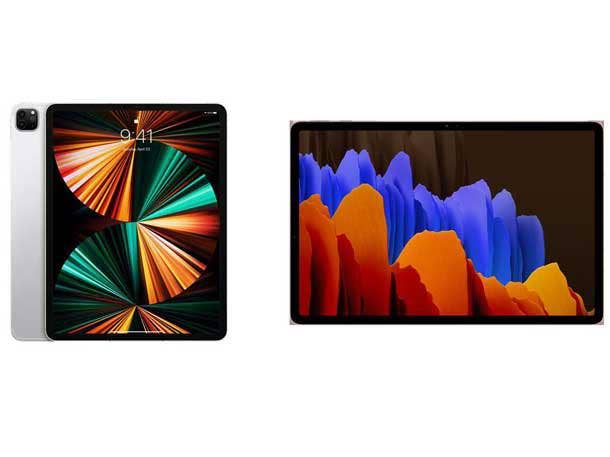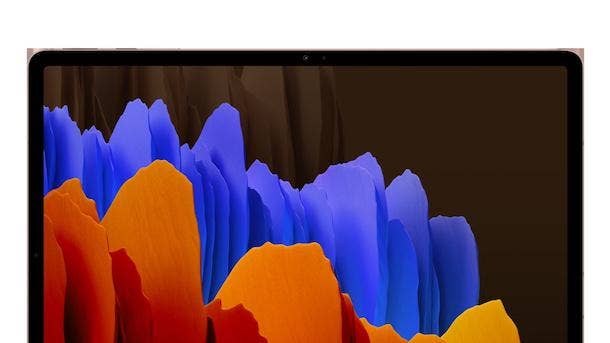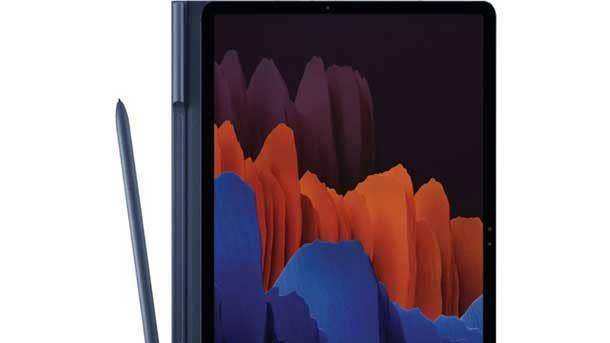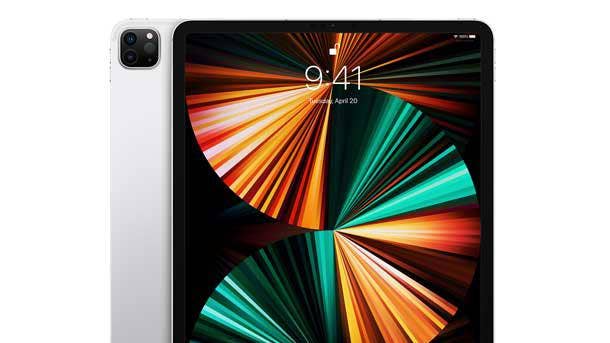Apple iPad Pro (M1) Vs. Samsung Galaxy Tab S7
In this head-to-head comparison, we look at the differences between Apple’s new iPad Pro with the M1 chip and Samsung’s latest 2-in-1 Android tablet.

Head-To-Head
Without a doubt, Apple’s move to bring its M1 processor to the new iPad Pro is a huge deal. For years Apple has touted the iPad Pro as a potential laptop replacement—and now, the 2-in-1 tablet will actually run a laptop processor thanks to the inclusion of the M1. The Apple-developed chip has already appeared in Macs including the MacBook Pro and MacBook Air, and now is even coming to the iMac. But Apple’s new iPad Pro is not alone among powerful 2-in-1 tablets on the market right now. And if you’re more inclined to use an Android tablet, you might want to check out one of Samsung’s latest offerings—the Galaxy Tab S7. Like the iPad Pro, the tablet comes in two sizes, with the larger size known as the Galaxy Tab S7 Plus. Along with strong performance and a choice of sizes, other similarities between the Galaxy Tab S7 and Apple’s new iPad Pro include 5G connectivity and support for an enhanced keyboard and stylus.
Which of the two tablets is the better fit for you? In the following slides, we compare Apple’s new iPad Pro (M1) vs Samsung’s Galaxy Tab S7 on price, features and specs.
Display
Apple’s new iPad Pro offers two display sizes, with the smaller model featuring an 11-inch display. The display on the Samsung Galaxy Tab S7 also measures 11 inches. For the larger models, the iPad Pro display reaches 12.9 inches, while the Galaxy Tab S7 Plus is not quite as large at 12.4 inches.
Both displays offer vibrant and colorful image quality, though only the Samsung tablets offer OLED displays. Apple sticks with LCD, but does upgrade the iPad Pro display technology on the 12.9-inch model. The larger model offers what Apple is calling its Liquid Retina XDR display, which makes use of mini-LED technology; the technology includes 10,000 LEDs to create a more-realistic visual experience, Apple said. The brightness on the 12.9-inch iPad Pro can reach up to 1,000 nits for full screen, and up to 1,600 nits for peak brightness. Maximum brightness on the 11-inch iPad Pro is 600 nits. The iPad Pro models both include resolution of 264 pixels per inch (ppi).
For the Galaxy Tab S7 and S7 Plus, resolution is similar at 276 ppi and 266 ppi, respectively. The tablets offer high brightness at 500 nits, though not quite as high as the iPad Pro brightness. Both the iPad Pro and Galaxy Tab S7 also offer a 120hz refresh rate for smoother display motion. All in all, users should not be disappointed with the display quality on either tablet as both offer some of the very best display technologies available in 2021.

Performance and Connectivity
At Apple’s recent product event, the addition of the previously Mac-only M1 processor to the iPad Pro was among the biggest announcements—and biggest surprises. The M1 is an Arm-based chip that Apple has developed in house with the aim of enhancing performance and battery life. While the iPad Pro with M1 is not available just yet, previous benchmarks for the M1 suggest a major performance advantage for the chip. One recent benchmark found the M1 beating nearly all of Intel’s latest 11th-gen processors, for instance. The processor in the Galaxy Tab S7 is the Qualcomm Snapdragon 865 Plus Mobile Platform, which Samsung has touted as “the fastest processor in a Galaxy Tab ever”—featuring up to 25-percent faster CPU performance and up to 36-percent faster graphics performance than the Tab S6. While that processor makes the Galaxy Tab S7 faster than most Android tablets on the market, Geekbench 5 benchmark scores for the M1 and Snapdragon 865 Plus show a sizable speed advantage for the M1, both in single-core and multi-core tests. Memory also impacts performance, of course, and the iPad Pro also offers 8GB or 16GB of RAM—compared to 6GB or 8GB for the Galaxy Tab S7.
Other major upgrades on the new iPad Pro models include the addition of support for 5G for the first time. Samsung beat out Apple in that regard, however, launching variants of the Galaxy Tab S7 that supported 5G last year—which at the time were the first tablets to support 5G in the U.S. Both the Apple and Samsung tablets support the higher-speed version of 5G, known as mmWave, as well as sub-6 5G.

Stylus and Keyboard
Both the new iPad Pro and Galaxy Tab S7 are designed to work well with digital pens. The Galaxy Tab S7 and S7 Plus offer an advantage here by including the S Pen stylus with the purchase of the tablet—whereas the stylus that can be used with the iPad Pro, the second-gen Apple Pencil, is sold separately.
Notably, the latest S Pen for the Tab S7 has been redesigned to have lower latency and remote-control capabilities, such as taking a picture or skipping a slide by pressing a button on the stylus.
For the keyboard, Apple continues to offer a Magic Keyboard option for the iPad Pro (sold separately). The Magic Keyboard uses a scissor mechanism and offers 1 mm of key travel for an improved typing experience, along with an included trackpad. The new iPad Pro is also compatible with the previous keyboard design, the Smart Keyboard Folio, which does not offer a trackpad.
The Galaxy Tab S7 can be used with a keyboard that doubles as a case for the tablet (sold separately). The Book Cover Keyboard for the Tab S7 has gotten improvements with the addition of 16 function keys—including escape and delete keys, and a key for launching the DeX Android desktop—as well as a larger touchpad.

Battery Life and Storage
For battery life, the iPad Pro offers up to 10 hours on a charge. Samsung doesn’t provide a battery life estimate for the Galaxy Tab S7, saying only that it includes a “long-lasting” battery. We’d tend to believe the claims, due to Samsung’s inclusion of size battery capacities in the tablet--8,000mAh in the Galaxy Tab S7 and 10,090mAh in the Tab S7 Plus.
On internal storage, the new iPad Pro and the Galaxy Tab S7 both offer 128 GB, 256 GB or 512 GB. However, the new iPad Pro models also offer two additional storage configurations, with a stunning 1 TB or 2 TB of internal storage. Using a microSD card with the Galaxy Tab S7 can add up to another 1 TB of storage to the tablet.

Price and Availability
Apple’s new iPad Pro models with M1 are available to order now, but shipping times are now running into late May and beyond. The Apple website shows the base model 11-inch iPad Pro currently shipping between May 24 and June 1—but the 12.9-inch model will take even longer to get, with Apple’s shipping dates listed as between July 1 and July 15.
In terms of pricing, the cheapest tablet in our comparison is the Galaxy Tab S7, which starts at $649.99 with Wi-Fi-only. The 11-inch iPad Pro has a starting price of $799 for the Wi-Fi-only model. For the Galaxy Tab S7 Plus, you’ll need to pay $849.99—while 12.9-inch iPad Pro is the priciest tablet in our comparison, starting at $1,099. For both tablets, models that support 5G connectivity start at $200 higher than the Wi-Fi-only models.
Keep in mind that these prices do not include a keyboard (or a stylus for the iPad Pro). The keyboard prices vary depending on the model. The Magic Keyboard for the iPad Pro is priced at $299, while the Book Cover Keyboard for the Galaxy Tab S7 is priced at $199.99.